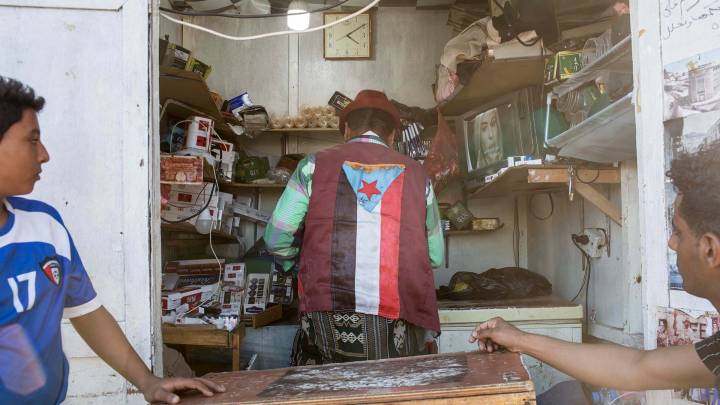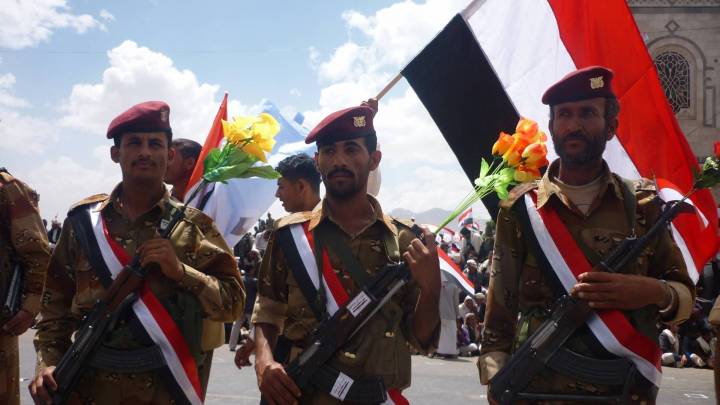The shifts within Yemen’s political elite opened space for otherwise junior figures filling leadership vacuums. One case in particular, the rise of Aydarous Zubaydi, has made as significant an impact as the fall of major historical figures.
The fall of major political figures over the past eight years had a direct impact on the course of the conflict in Yemen, while the rise of new actors has sparked hope among certain segments of the population. Such consequences have fractured the country along political lines and even created de facto borders between areas controlled by the Houthis and their rivals, while southern Yemen has experienced a unifying period under a more cohesive and pro-active leadership. The emergence of the Southern Transitional Council (STC) reinvigorated southern determination under a new banner, moving away from the established ‘peaceful movement’, based on civil disobedience, to full engagement in the fight against the Houthis and direct involvement in national politics.
The rise of an actor like Aydarous Zubaydi is often not accidental. The president of the STC and commander of the Joint Southern Forces has come a long way from his upbringing in the village of Zubaid in al-Dhale province in the period of the People’s Democratic Republic of Yemen (PDRY). His political and military leadership role since the liberation of Aden has been a product of military experience and his role in the southern resistance.
Zubaydi was born on 23 July 1967, he moved to Aden following primary and secondary schooling in his village. He joined the Air Force College in 1986, a time of political turmoil in southern Yemen, graduating two years later with the rank of second lieutenant. Following unification in May 1990, Zubaydi moved to Sana’a where he became a security commander in the Embassy Security Unit within the Ministry of Interior. Staying loyal to the South, Zubaydi sided with then Vice-President Ali Salem al-Baydh in the secessionist war of 1994. Following defeat of the southern secessionist forces, like many other southerners, Zubaydi fled Yemen to Djibouti until 1996.
After the defeat in 1994, southern activists were split between pursuing peaceful civil disobedience and armed resistance
While he participated in the civil war of 1994, his experience in the resistance movement really began in 1996. While in Djibouti, Zubaydi helped establish the Hatem (Self-Determination) Movement, a southern armed resistance group formed to carry out covert attacks on military posts of the forces “occupying the south”. This comes at a time when southerners adopted the narratives against northern occupation following the defeat in 1994 and a crackdown by Sana’a against those advancing southern self-determination and a return of the PDRY state. In 1997, Zubaydi was tried in absentia by a Sana’a military tribunal and sentenced to death along with other southern officers.
After the defeat in 1994, southern activists were split between pursuing peaceful civil disobedience and armed resistance. The primary goal was to attract the attention of the international community and shed a light on crimes committed by the Sana’a regime as well as focus on the right to self-determination within the framework of invalidating the unification of 1990. Southerners were split on whether to pursue the path to resistance.
The divide between southern groups from 1994 to 2007 obstructed progress on southern ambitions. Yet, the emergence of Hirak, the Southern Movement, in protest to increased marginalization of southerners in civil service jobs and the military, reinvigorated the resistance. This revival coincided with the war in Sadah between the Sana’a government and Zaydi Shia Houthi rebels. Hirak unified the southern political figures within and beyond Yemen’s borders. The movement attracted a new generation of young activists grabbing a hold of the narratives against northern occupation and demands for self-determination. The youth reached back to a country many did not experience but longed for as a consequence of marginalization within unified Yemen.
Zubaydi secured military assistance from the Arab Coalition
The sentiment grew among the youth as the Arab Spring reached Yemen in February 2011. While armed conflict erupted across northern Yemen between pro-Saleh forces and elements aligned with Yemen’s Muslim Brotherhood affiliate al-Islah, southerners organized sit-ins in Aden and peaceful protests across southern provinces. As Sana’a authorities ordered crackdowns on demonstrators in Aden, political groups and the general population refrained from organizing an armed uprising similar to the course of events in Amran, Mareb or Taiz.
A segment of the population across the south demanded from their leaders to meet northern aggression with force. Leaders like Zubaydi were prepared, with hundreds of trained men and light weapons, but restraint was the order from the organized leadership in Hirak. Leaders wanted the world to see the heavy-handed approach taken by Sana’a authorities, which continued following the transfer of power from Saleh to Hadi in February 2012. Unarmed civilian protesters were met with force by security forces now under the authority of a president of southern origin.
The new war between Houthis and the Sana’a government reached Aden in March 2015. The Houthi march south represented both an existential threat and a long-awaited opportunity for southern leaders. Their survival demanded a multi-pronged response, including armed resistance.
The approach taken since 2007 was no longer adequate, as the new enemy once again came to ‘conquer’ the south. Houthi rebels were not only chasing president Hadi and removing Islah affiliates in Aden, their aggression aimed at submitting southerners to their grip on power. This was a time for leaders like Aydarous Zubaydi to step to the forefront of the southern resistance and shape its path.
Zubaydi was in the perfect position, in command of hundreds of well-trained men, and through relations with the Gulf, cemented by allies from Yaf’a living in the UAE, Zubaydi secured military assistance from the Arab Coalition. First, elements aligned with the Hatem Movement pushed Houthi fighters out of central al-Dhale province toward borders with al-Baydha and Ibb provinces. His forces then participated in the liberation Yemen’s largest air base at al-Anad in Lahj.
Forces under Zubaydi and his allies were among the most effective against northern forces
Forces under Zubaydi and his allies were among the most effective against northern forces. The liberation of Aden in July 2015 was facilitated by organized militias on the fringes and enough weapons and vehicles provided by the Saudi Arabia-led coalition. The forces under Zubaydi and other southern leaders then organized against terrorist elements of al-Qaeda in the Arabian Peninsula (AQAP) and Islamic State in Yemen (IS-Y). A year of counter-terrorism operations cleared Aden of AQAP and ISIS elements, months after Aydarous Zubaydi was appointed governor of Aden.
Zubaydi served nearly a year and a half as governor before being fired by president Hadi in April 2017. Once again, Zubaydi seized an opportunity, gathered a wide range of allies from across the eight southern provinces and announced the formation of the twenty-six-member Southern Transitional Council (STC) in May. Later that year, the STC formed a 303 member National Assembly and offices across the south.
This new approach led by Aydarous Zubaydi not only strengthened his profile but placed southern forces as a new emerging center of power in Yemen. The STC has managed to unify a highly diverse group of southerners who now rally behind a common narrative, especially after a number of significant military victories in Abyan, Aden and Shebwa. As influence increased and pro-STC forces gained control on the ground, Aydarous Zubaydi gained recognition among western government and the Saudi Arabia-led coalition in particular.
In a surprised move during a gathering of Yemeni officials and political activists, president Hadi stepped down in April. This paved the way for establishment of a new eight-member Presidential Leadership Council (PLC), with Aydarous Zubaydi representing the south. This position has placed southern grievances at the center of Yemen politics. Southerners are once again united under one leadership, raising hopes of a new beginning and a more equitable distribution of resources in months and years to come.




